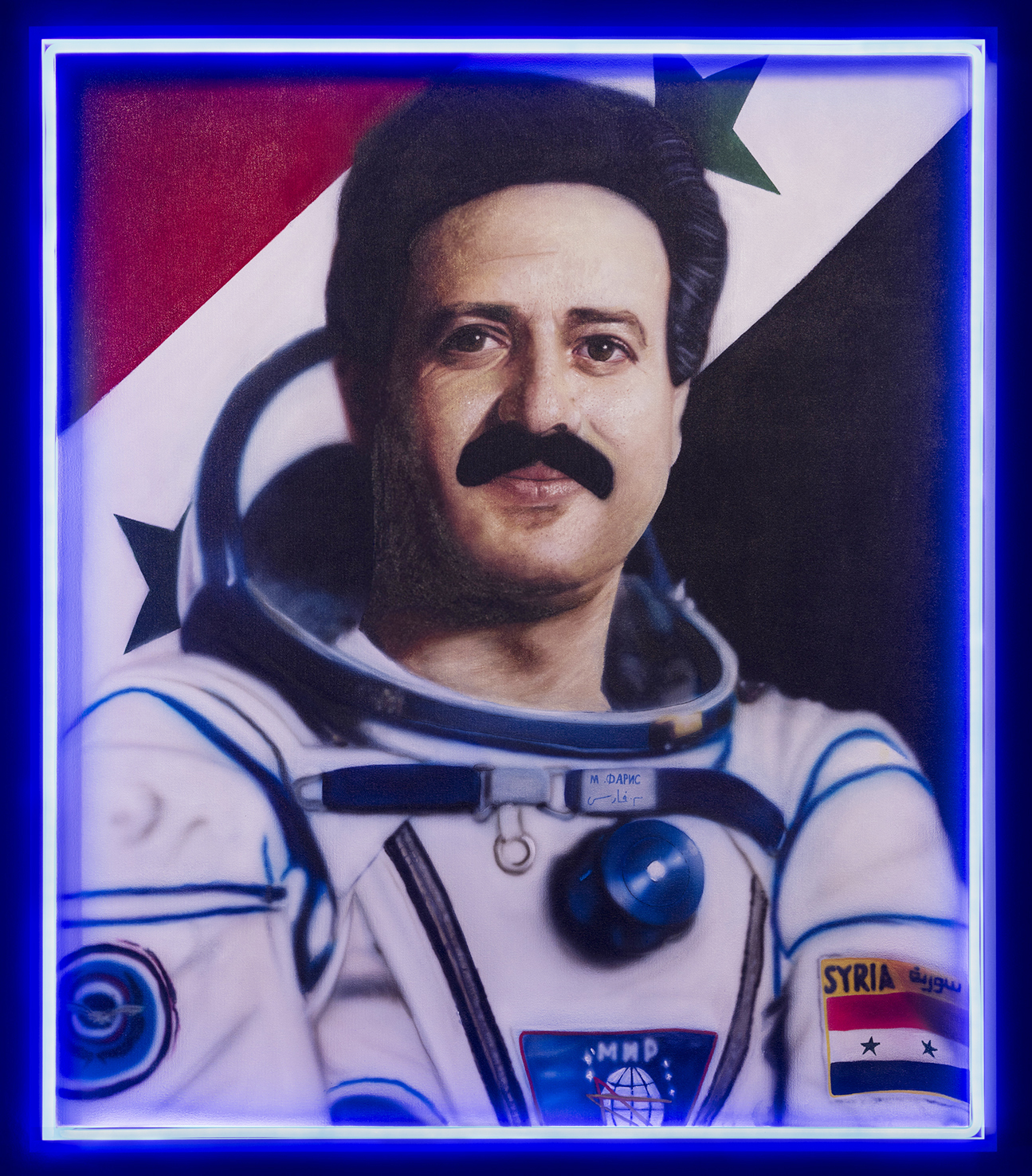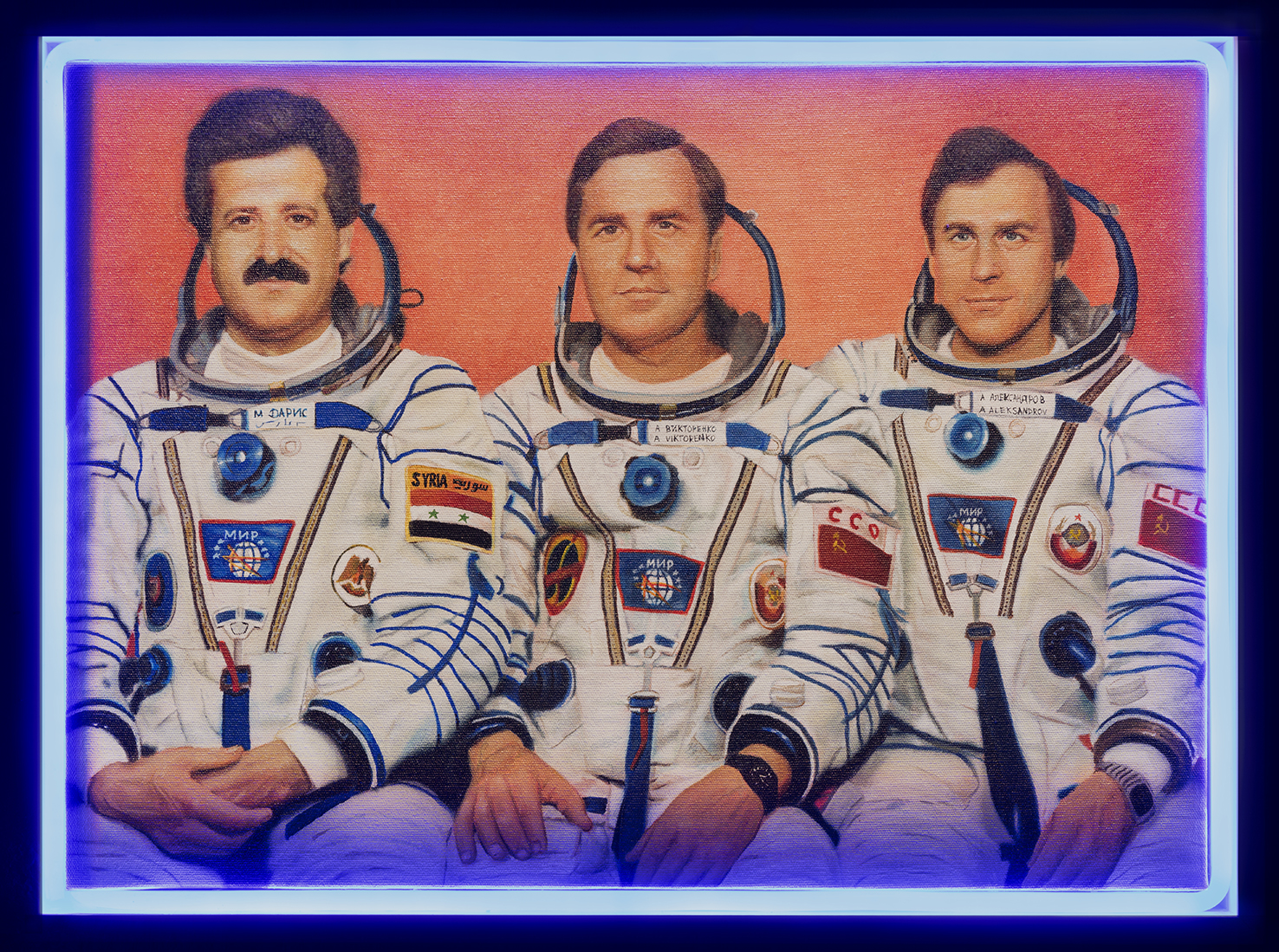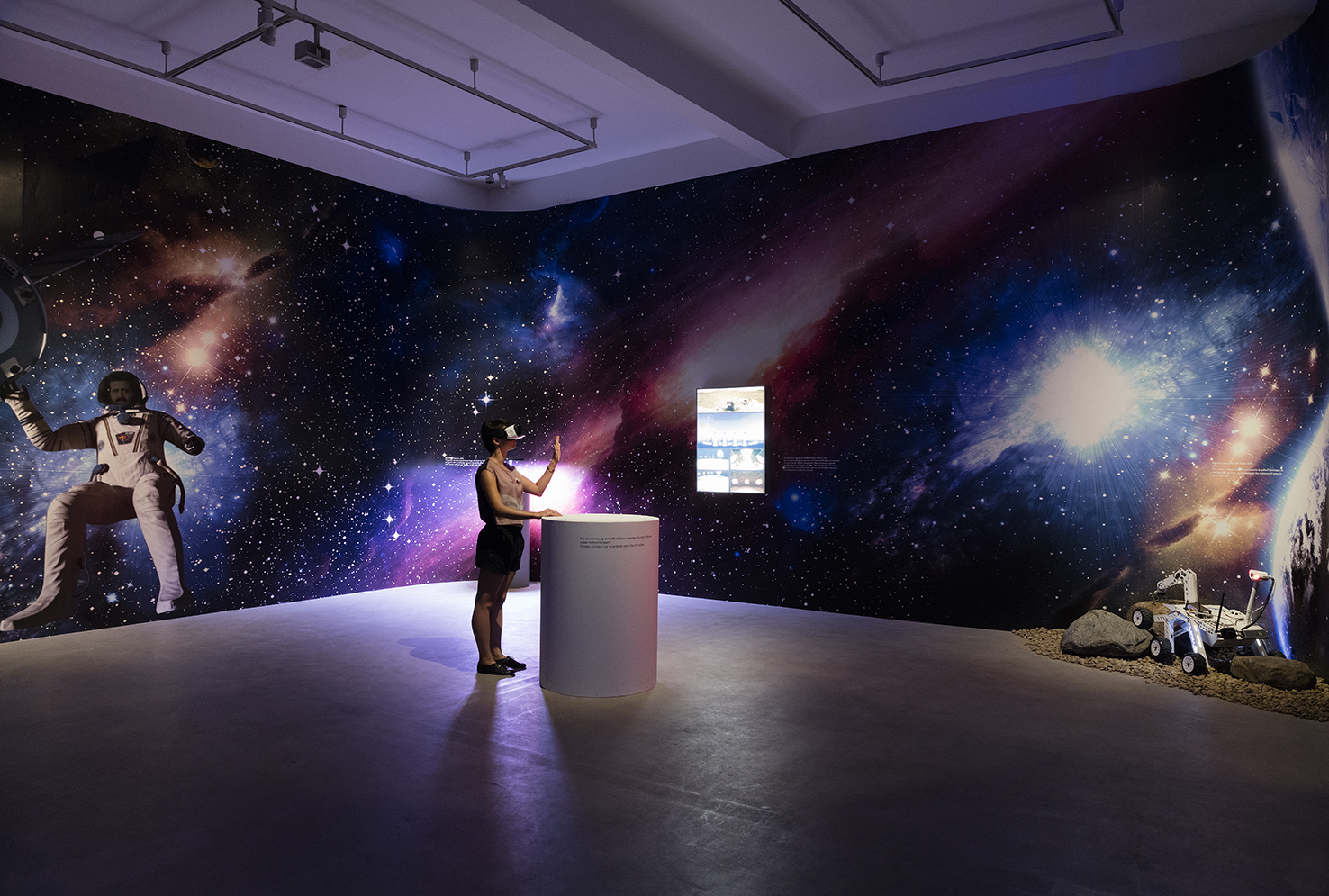Twenty-five years before he escaped to Kocamustafapaşa, a conservative neighborhood in Istanbul, Mohammed Ahmed Faris was the first Syrian to travel to space. As a fighter pilot in the Syrian Army, Faris was handpicked for a joint Syrian-Russian space program and spent two years in Moscow training to become an astronaut.On July 22, 1987, Faris started his historic journey to the Russian space station Mir. “We are now flying over our lovely country, Syria,” he proudly announced as his spacecraft flew into orbit. On earth, cameras were rolling in the presidential office of Hafiz al-Assad, whose image was broadcast live on national television as he listened to Faris sending all his “deepest respect and love” to him. The visuals fit into typical nationalist propaganda, but they also touch on the ethereal. In the audio recording, Faris’ voice is filled with joy, pride, and a touch of religious ecstasy. “From here I can see the beautiful coasts, the green mountains and lands of my country.”Today, that serene image of his country is even further from Faris than it was when he looked down upon it during his orbit of Earth.The former astronaut and national hero now lives in a two-bedroom apartment with five other family members in Istanbul. He escaped from Syria five years ago. Halil Altındere, one of Turkey’s leading contemporary artists, has transformed Faris’ national icon and story into a new video installation that is at once nostalgic, political, and satirical. In the video “Space Refugee” — on display as part of the artist’s solo show at New York’s Andrew Kreps gallery this January — Altındere raises metaphysical questions about the Syrian war, the effects of the migration crisis, and the future of mankind. Faris, who spent eight days in space conducting scientific experiments, serves as the project’s sort-of Yoda figure.The former Syrian hero seems perfectly at home in such a role, having experienced both the wrenching suffering in Syria (whose territory has been claimed by various warring parties during its bloody five-year civil war) and the freedom of space (which is not subject to any claims of sovereignty).“My purpose was to protect the skies of my country, not to kill my people,” he tells Altındere.In 2011, when the Syrian uprising began, Faris ranked as a major general in the Syrian Air Force, but he left the country in protest after Assad’s government forces turned violent against protesters.“I came to Turkey to express my feelings and stand against injustice and tyranny in my country, and help my people in Syria. I believe that the free word is stronger than cannons and bullets.”The astronaut’s journey to the Turkish border was a difficult one: As the highest-ranking defector from Syria, he was closely watched and had to discreetly take his wife and children to a car, drive to the Turkish border, and illegally cross barbed wire into the border town of Kilis, where Turkish intelligence agents picked him up and questioned him. He eventually landed in Istanbul.
Halil Altındere, one of Turkey’s leading contemporary artists, has transformed Faris’ national icon and story into a new video installation that is at once nostalgic, political, and satirical. In the video “Space Refugee” — on display as part of the artist’s solo show at New York’s Andrew Kreps gallery this January — Altındere raises metaphysical questions about the Syrian war, the effects of the migration crisis, and the future of mankind. Faris, who spent eight days in space conducting scientific experiments, serves as the project’s sort-of Yoda figure.The former Syrian hero seems perfectly at home in such a role, having experienced both the wrenching suffering in Syria (whose territory has been claimed by various warring parties during its bloody five-year civil war) and the freedom of space (which is not subject to any claims of sovereignty).“My purpose was to protect the skies of my country, not to kill my people,” he tells Altındere.In 2011, when the Syrian uprising began, Faris ranked as a major general in the Syrian Air Force, but he left the country in protest after Assad’s government forces turned violent against protesters.“I came to Turkey to express my feelings and stand against injustice and tyranny in my country, and help my people in Syria. I believe that the free word is stronger than cannons and bullets.”The astronaut’s journey to the Turkish border was a difficult one: As the highest-ranking defector from Syria, he was closely watched and had to discreetly take his wife and children to a car, drive to the Turkish border, and illegally cross barbed wire into the border town of Kilis, where Turkish intelligence agents picked him up and questioned him. He eventually landed in Istanbul. He bolsters the project through interviews with NASA personnel (Umut Yıldız and Alper Aydemir, from NASA’s Jet Propulsion Laboratory), an aviation lawyer, and a Turkish architect who collectively imagine the finer details of setting up a refugee colony on Mars.“We Syrians are the sons of civilization, sons of history,” Faris muses in the video. “We built human civilization 10,000 years ago. We gave humanity its first alphabets, first agriculture systems, first mining techniques… We will rebuild Syria and we can even rebuild all of the planets in the Solar System.”Syrians were the first to refine iron on Earth, Faris declares, so a new wave of Syrian refugees can do the same on Mars. “It is proven scientifically that Mars is very rich in iron. We will build space there and I will go with them to Mars, where we find safety and freedom.”Apparently, we soon learn, Mars is the best candidate for a Syrian colonization — it is not extremely hot, one can actually inhabit it, and it has land free for the taking. The only problem with the Mars Colony project is that it takes about a year to travel there and transportation of materials is extremely costly. The solution, Altındere’s interviewees suggest lightheartedly, is to bring 3D printers to the uninhabited planet and let them build everything there.
He bolsters the project through interviews with NASA personnel (Umut Yıldız and Alper Aydemir, from NASA’s Jet Propulsion Laboratory), an aviation lawyer, and a Turkish architect who collectively imagine the finer details of setting up a refugee colony on Mars.“We Syrians are the sons of civilization, sons of history,” Faris muses in the video. “We built human civilization 10,000 years ago. We gave humanity its first alphabets, first agriculture systems, first mining techniques… We will rebuild Syria and we can even rebuild all of the planets in the Solar System.”Syrians were the first to refine iron on Earth, Faris declares, so a new wave of Syrian refugees can do the same on Mars. “It is proven scientifically that Mars is very rich in iron. We will build space there and I will go with them to Mars, where we find safety and freedom.”Apparently, we soon learn, Mars is the best candidate for a Syrian colonization — it is not extremely hot, one can actually inhabit it, and it has land free for the taking. The only problem with the Mars Colony project is that it takes about a year to travel there and transportation of materials is extremely costly. The solution, Altındere’s interviewees suggest lightheartedly, is to bring 3D printers to the uninhabited planet and let them build everything there. Altındere pointedly offers a VR experience of this new world. “Journey to Mars,” a 360-degree video that accompanies the main film, allows visitors to tour Altındere’s Mars colony through VR headsets. The fictional colony resembles the underground caves of Turkey’s Cappadocia.“I wanted viewers to empathize with space refugees,” Altındere told me. Numerous people had taken Faris’s story simply as fiction and this reception led Altındere to offer VR as a way to directly confront his audience with the project’s grimmer implications. With the headset on, the viewer is forced to walk beside Faris and three young Syrians as they wander their new, distant home.“Civilized countries escape from facing realities. With this there was no other way but to face them,” Altındere told me as we watched “Space Refugee” from his laptop in his studio. “If no country wants them, why don’t we settle the world’s refugees on Mars? That is the reality people face here.”It is a startling question, and one that’s hard to ignore as the world turns its attention to the many horrors still coming from inside Aleppo.Altındere’s project flirts with the humorous and wholly unreal at times, but at its foundation is a deadly serious statement. It is the artist’s modern version of Swift’s modest proposal with a conceit that is equally damning.The imaginary exodus to Mars would likely come as welcome news to many European politicians eager to get rid of Syrian refugees now living in their countries. It might even come as welcome news to many Syrian refugees themselves.At one point in the film, Faris urges his fellow Syrians to be patient before recounting the many injustices of the world: “There is no freedom on earth, there is no dignity for humans on earth… A man always longs for his home country and homeland. And we will go back to our country if it’s God’s will.”Kaya Genc is an essayist from Istanbul. He is the author of “Under the Shadow: Rage and Revolution in Modern Turkey” (I.B. Tauris).
Altındere pointedly offers a VR experience of this new world. “Journey to Mars,” a 360-degree video that accompanies the main film, allows visitors to tour Altındere’s Mars colony through VR headsets. The fictional colony resembles the underground caves of Turkey’s Cappadocia.“I wanted viewers to empathize with space refugees,” Altındere told me. Numerous people had taken Faris’s story simply as fiction and this reception led Altındere to offer VR as a way to directly confront his audience with the project’s grimmer implications. With the headset on, the viewer is forced to walk beside Faris and three young Syrians as they wander their new, distant home.“Civilized countries escape from facing realities. With this there was no other way but to face them,” Altındere told me as we watched “Space Refugee” from his laptop in his studio. “If no country wants them, why don’t we settle the world’s refugees on Mars? That is the reality people face here.”It is a startling question, and one that’s hard to ignore as the world turns its attention to the many horrors still coming from inside Aleppo.Altındere’s project flirts with the humorous and wholly unreal at times, but at its foundation is a deadly serious statement. It is the artist’s modern version of Swift’s modest proposal with a conceit that is equally damning.The imaginary exodus to Mars would likely come as welcome news to many European politicians eager to get rid of Syrian refugees now living in their countries. It might even come as welcome news to many Syrian refugees themselves.At one point in the film, Faris urges his fellow Syrians to be patient before recounting the many injustices of the world: “There is no freedom on earth, there is no dignity for humans on earth… A man always longs for his home country and homeland. And we will go back to our country if it’s God’s will.”Kaya Genc is an essayist from Istanbul. He is the author of “Under the Shadow: Rage and Revolution in Modern Turkey” (I.B. Tauris).
Advertisement

Advertisement
For Altındere, this is the beginning of Faris’s story rather than its end. Here, the artist explores the astronaut’s legend not as a space traveler but as a refugee.In a deadpan manner, the artist organizes a scientific investigation around the idea that Syrian refugees can travel to Mars and start a civilization there, just like they did on Earth so long ago. In contrast with their representation in Western media as a group of sad, helpless, and melancholy people, Altındere portrays Syrian refugees as the very saviors of humanity.“We Syrians are the sons of civilization, sons of history.”

Advertisement

Advertisement